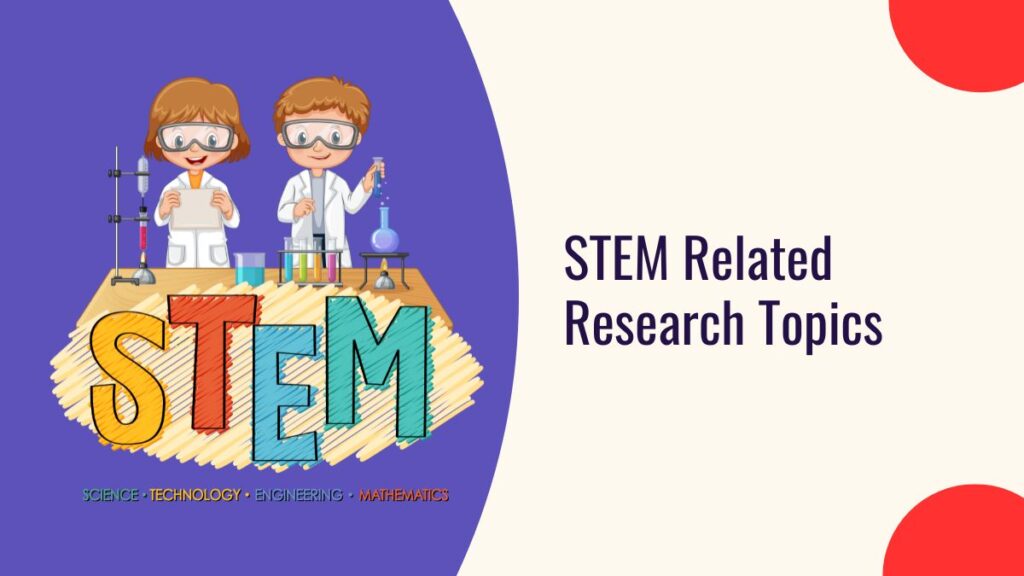Find simple and interesting STEM related research topics! Great for students, these ideas cover science, technology, engineering, and math projects.
Have you ever wondered why STEM (Science, Technology, Engineering, and Mathematics) is so popular today? There’s a good reason for it. Did you know that over 65% of future jobs will need skills in STEM? That’s a lot! The world is changing fast, and many jobs of the future will need these skills.
When students start learning STEM early, they become better at solving problems and thinking critically. They learn how to ask questions, try experiments, and find solutions. In fact, studies show that students involved in STEM often do better in school. They gain knowledge and also useful skills that can help them in everyday life.
With new technology developing quickly, understanding STEM can open many doors. Imagine working on projects like creating green energy, making life-saving tech, or building the latest apps. These are all part of the STEM world. So, let’s explore some fun and easy STEM research topics to inspire students to get started.
STEM Related Research Topics PDF
What Research Topic Is Related To Stem?
STEM research topics focus on subjects within Science, Technology, Engineering, and Mathematics. These topics encourage students to explore the world scientifically and technically. Examples include:
- The impact of renewable energy on reducing carbon footprints.
- How AI (Artificial Intelligence) is changing healthcare.
- Understanding the process of photosynthesis in plants.
- The physics behind how airplanes stay in the air.
- Exploring the use of robotics in manufacturing.
What Are Simple Research Topics?
Simple research topics are straightforward subjects that are easy to understand and explore, especially for beginners. Examples include:
- How do magnets work?
- The life cycle of a butterfly.
- Why does salt melt ice faster than sugar?
- How do different materials affect plant growth?
- What causes rainbows to form?
What Is A Stem Research Project?
A STEM research project involves exploring questions and solving problems using scientific, technological, engineering, or mathematical methods. The goal is to encourage hands-on learning and critical thinking. Examples of STEM projects could include:
- Building a model solar-powered car.
- Designing a simple robot that can follow a path.
- Conducting experiments to find the best way to filter water.
- Studying the effects of different fertilizers on plant growth.
- Creating a computer program to solve a specific problem.
What Are Examples Of Stem Projects?
STEM projects encourage students to use their creativity while applying STEM concepts. Here are some examples:
- Building a bridge out of popsicle sticks to see how much weight it can hold.
- Making a simple circuit to power a lightbulb.
- Constructing a miniature wind turbine to generate electricity.
- Creating a coded game or app.
- Experimenting with baking soda and vinegar to explore chemical reactions.
What Is The Best Research Topic For Students?
The best research topic for students is one that sparks their curiosity and matches their level of understanding. Great topics can include:
- How does pollution affect marine life?
- The role of bees in food production.
- How do vaccinations protect people from diseases?
- The benefits of recycling and waste management.
- Exploring how different types of soil impact plant growth.
STEM Related Research Topics For Students
Here are some of the best STEM related research topics for students:
Biology & Life Sciences
- Effects of different light colors on plant growth
- Impact of music on plant development
- Natural alternatives to chemical pesticides
- Bacterial growth in different temperatures
- Effect of caffeine on heart rate
- Memory retention techniques comparison
- Sleep patterns and academic performance
- Local ecosystem Biodiversity Study
- Composting efficiency methods
- Plant growth in different soil types
- Effects of sugar on tooth decay
- Impact of exercise on mental alertness
- Effectiveness of natural antibacterial substances
- Bird migration patterns in your area
- Effects of pollution on local plant life
Chemistry
- Natural vs. chemical cleaning products
- Crystallization of different substances
- Rust formation under various conditions
- pH levels in common beverages
- Making biodegradable plastics
- Water purification methods
- Chemical reactions in cooking
- Properties of different types of soap
- Natural dye extraction methods
- Acid rain effects on plants
- Salt crystal formation
- Chemical changes in food preservation
- Properties of different metals
- Electrolysis of different solutions
- Antioxidant levels in foods
Physics & Engineering
- Solar oven construction and efficiency
- Simple electric motor design
- Wind turbine blade efficiency
- Bridge design strength testing
- Sound insulation materials comparison
- Simple machines efficiency study
- Renewable energy comparisons
- Friction on different surfaces
- Paper airplane design optimization
- Magnetic field strength testing
- Heat conductivity of materials
- Solar cell efficiency factors
- Pendulum motion patterns
- Pulley system efficiency
- Rocket design and thrust
Computer Science & Technology
- Password strength analysis
- Social media usage patterns
- App development for daily problems
- Computer energy efficiency
- Basic encryption methods
- Weather prediction algorithms
- Website load time optimization
- Digital art creation tools
- Game design principles
- Data compression techniques
- Voice recognition accuracy
- QR code applications
- Smart home automation
- Cybersecurity basics
- Mobile app battery usage
Mathematics & Statistics
- Golden ratio in nature
- Probability in daily life
- Statistical analysis of social media
- Mathematical patterns in music
- Traffic flow optimization
- Sports statistics analysis
- Weather pattern prediction
- Financial Mathematics
- Geometric patterns in architecture
- Population growth models
- Game theory applications
- Data visualization methods
- Risk assessment models
- Cost-benefit analysis
- Mathematical art creation
Environmental Science
- Water quality testing
- Solar power efficiency
- Waste reduction methods
- Air quality monitoring
- Recycling effectiveness
- Carbon footprint reduction
- Urban heat island effect
- Biodegradable materials testing
- Energy conservation methods
- Green roof benefits
- Sustainable transportation
- Pollution reduction strategies
- Alternative energy sources
- Climate change indicators
- Ecosystem restoration
Space & Astronomy
- Moon phase effects
- Star brightness measurement
- Planet observation methods
- Telescope construction
- Solar system modeling
- Meteorological predictions
- Light pollution effects
- Satellite tracking
- Mars colonization concepts
- Space debris solutions
- Astronomical photography
- Cosmic ray detection
- Space weather effects
- Asteroid tracking methods
- Space habitat design
Robotics & AI
- Simple robot construction
- Basic AI chatbot development
- Automated plant watering system
- Motion sensor applications
- Voice command systems
- Line-following robots
- Facial recognition basics
- Automated sorting systems
- Smart lighting control
- Robot navigation methods
- Machine learning basics
- Gesture control systems
- Object detection systems
- Autonomous vehicles basics
- Smart home integration
Health & Medicine
- Hand washing effectiveness
- Exercise impact studies
- Diet and energy levels
- Vision testing methods
- Reaction time studies
- Ergonomic design testing
- Health app development
- Stress reduction techniques
- Sleep quality factors
- Heart rate monitoring
- Posture improvement methods
- Hearing protection study
- Mental health technologies
- Fitness tracking analysis
- Nutrition study methods
Agricultural Science
- Hydroponics systems
- Soil quality testing
- Crop rotation benefits
- Organic farming methods
- Pest control techniques
- Plant growth factors
- Irrigation efficiency
- Greenhouse design
- Vertical farming methods
- Seed germination studies
- Fertilizer comparison
- Weather impact on crops
- Sustainable farming
- Agricultural automation
- Food preservation methods
Interdisciplinary Topics
- Biomimicry applications
- Sports science analysis
- Music and mathematics
- Art and technology
- Food science studies
- Sustainable design
- Bioinformatics basics
- Health technology
- Environmental engineering
- Smart city concepts
- Renewable materials
- Digital Humanities
- Science communication
- Citizen science projects
- STEM education methods
Tips for Choosing a STEM Related Research Topics
Here are the important points for choosing easy stem related research topics:
- Consider available resources and equipment
- Match the topic to your skill level
- Think about practical applications
- Ensure the scope is manageable
- Consider the time frame available
- Look for local relevance
- Check for safety considerations
- Assess data collection methods
- Consider budget constraints
- Think about presentation methods
Research Project Structure
- Define your research question
- Develop a hypothesis
- Plan your methodology
- Gather materials and resources
- Conduct experiments/research
- Collect and analyze data
- Draw conclusions
- Present your findings
- Consider future implications
- Document everything carefully
Good Research Topics and Titles Related to STEM
- “How Renewable Energy Helps Reduce Carbon Emissions”
This research looks at how renewable energy like solar and wind power helps the environment. - “How AI is Improving Healthcare”
This topic explores how Artificial Intelligence is making healthcare better by improving diagnosis. - “The Effect of Online Learning Tools on STEM Education”
This study looks at how online learning tools help STEM students learn better. - “How Study Habits Affect Grades in STEM Fields”
This research studies how different study habits influence students’ grades in STEM subjects. - “The Efficiency of Solar-Powered Water Purifiers”
This topic looks at how well solar-powered water purification systems work in providing clean water.
Quantitative Research Titles for STEM Students
- “How Temperature Affects Chemical Reactions”
This study measures how changing temperatures affect the speed of chemical reactions. - “The Impact of Internet Speed on Online Learning Performance”
This research checks how internet speed affects students’ performance in online STEM classes. - “How Soil Types Affect Plant Growth”
This topic compares how different types of soil impact the growth of plants. - “Comparing Solar Panel Designs for Efficiency”
This study compares the energy efficiency of different solar panel designs. - “The Relationship Between Screen Time and Academic Performance”
This research looks at how screen time affects the grades of STEM students.
Sample Research Titles About STEM Strand
- “The Role of Nanotechnology in Medicine”
This topic studies how tiny technology (nanotech) is used in medicine to improve treatments. - “How Sleep Affects Academic Performance in STEM Students”
This research looks at how the amount of sleep impacts STEM students’ grades. - “How Data Helps Tech Companies Make Better Decisions”
This topic explores how tech companies use data to make smart business decisions. - “How 3D Printing is Changing Product Design”
This research looks at how 3D printing is making product design faster and cheaper.
Best Quantitative Research Topics for STEM Students
- “The Effect of Climate Change on Crop Yields”
This research measures how changing weather patterns affect crops and farming. - “Comparing Energy Use in Electric and Gas Cars”
This study compares how much energy electric cars use compared to traditional cars. - “How Exercise Improves Brain Power in STEM Students”
This topic looks at how physical exercise can improve memory and focus for STEM students. - “Using Augmented Reality to Improve STEM Learning”
This research explores how AR technology helps STEM students understand difficult concepts. - “How Mobile Apps Help STEM Students Study More Efficiently”
This study checks how using study apps helps STEM students improve their learning.
What is a STEM project?
A STEM project involves hands-on activities that focus on Science, Technology, Engineering, and Mathematics. These projects encourage problem-solving, creativity, and the application of knowledge in real-world situations. Examples include building a simple robot, creating a solar-powered car, or designing an experiment to test plant growth under different conditions.
What is STEM in research?
STEM in research refers to studies or investigations in the fields of Science, Technology, Engineering, and Mathematics. It involves conducting experiments, gathering data, and analyzing results to answer questions or solve problems related to these fields. STEM research can focus on topics like climate change, technological advancements, or medical innovations.
What makes a project STEM?
A project is considered STEM if it involves principles from at least one of the four disciplines: Science, Technology, Engineering, or Mathematics. The project should require critical thinking, problem-solving, and the application of these subjects to explore or create something new.
For example, a project that builds a model bridge would involve engineering and math, while one that investigates renewable energy involves science and technology.
How to do STEM research?
To do STEM research, follow these steps:
- Choose a topic: Pick something in the fields of Science, Technology, Engineering, or Mathematics.
- Form a hypothesis: Make an educated guess about the outcome of your experiment or study.
- Design your experiment: Plan how you will gather data or test your hypothesis.
- Collect data: Conduct the experiment and record your observations.
- Analyze your results: Look for patterns in the data and see if it supports your hypothesis.
- Draw conclusions: Based on your findings, conclude whether your hypothesis was correct or not.
How to write a STEM research paper?
To write a STEM research paper, follow these steps:
- Title: Create a clear and specific title for your research.
- Abstract: Write a brief summary of your research question, methods, and findings.
- Introduction: Introduce the topic, state your hypothesis, and explain the importance of your study.
- Methods: Describe how you conducted your research or experiment.
- Results: Present the data you collected, often using graphs or tables.
- Discussion: Analyze the results and explain what they mean.
- Conclusion: Summarize your findings and suggest possible future research.
What is STEM R&D?
STEM R&D stands for Science, Technology, Engineering, and Mathematics Research and Development. It refers to the process of creating new knowledge, technologies, or products in these fields. This can involve developing new software, designing innovative engineering solutions, or conducting scientific studies to advance understanding in areas like medicine or environmental science.
Why is STEM research good?
STEM research is valuable because it leads to innovations and solutions that improve our daily lives. It can drive technological advancements, help solve global challenges like climate change, enhance healthcare, and create jobs. Additionally, STEM research encourages critical thinking, collaboration, and problem-solving, which are important skills for students and professionals.
Wrap Up
To sum it up, STEM topics are not just about theories. They help students understand how things work in real life. Whether it’s studying how plants grow or exploring how electric cars run, these topics help students think creatively and solve problems.
STEM skills are becoming more important. Technology and science are advancing every day. Having a strong STEM background can help students get good jobs in the future. In fact, jobs in STEM fields are growing 1.5 times faster than in other fields. This means learning STEM skills today is a smart move for tomorrow.
By exploring these topics, students can find something that interests them. This can spark their curiosity and love for learning. So, why wait? Choose a topic, start exploring, and step into the exciting world of STEM! The journey is fun, and the rewards are great.



